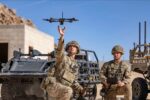At DSEI 2025 in London, Canadian armored vehicle manufacturer Roshel unveiled a new variant of its Senator Pickup platform featuring integrated counter-unmanned aerial system (C-UAS) capabilities. Designed for modularity and rapid mission adaptation, the vehicle targets growing demand for mobile drone defense solutions in contested environments.
Modular Platform Architecture Enables Mission Flexibility
The Senator Pickup is based on the proven Ford F-550 chassis but extensively modified by Roshel to meet military-grade survivability and mobility standards. The platform features a fully armored crew cabin (STANAG Level 1–2 protection depending on configuration), while the rear flatbed is designed as a modular payload bay capable of hosting various mission kits—including electronic warfare (EW), SHORAD/C-UAS systems, command posts, or logistics modules.
This modularity allows operators to reconfigure the vehicle within hours to meet evolving operational needs. At DSEI 2025, Roshel showcased a C-UAS configuration integrating radar sensors and electro-optical/infrared (EO/IR) tracking systems mounted on a telescopic mast behind the cab. The sensor suite is paired with an electronic countermeasure (ECM) package designed to jam or disrupt UAV control links across multiple frequency bands.
Integrated Counter-UAS Suite Offers Layered Drone Defense
The showcased C-UAS variant appears to integrate a multi-sensor architecture combining:
- Short-range air surveillance radar capable of detecting small UAVs (<10 kg class) at ranges up to ~3–5 km
- EO/IR turret for visual tracking and threat confirmation
- RF direction finding antennas for drone controller geolocation
- Electronic jamming module targeting GNSS signals and command/control links
This layered approach enables detection, identification, tracking, and non-kinetic neutralization of Group 1–2 drones (typically commercial quadcopters and fixed-wing UAVs under ~25 kg). While Roshel has not disclosed specific OEM partners for the C-UAS subsystems displayed at DSEI—likely due to export sensitivities—industry sources suggest integration with off-the-shelf solutions from European or Israeli vendors.
Operational Use Cases: Border Security to Battlefield SHORAD
The Senator Pickup’s compact footprint and off-road mobility make it well-suited for both military and paramilitary applications. Potential use cases include:
- Forward-deployed SHORAD/C-UAS nodes: Supporting maneuver units in high-threat drone environments such as Ukraine or Middle East theaters.
- Base protection: Deployable around airfields or logistics hubs vulnerable to FPV drone strikes.
- Civilian infrastructure defense: Guarding critical assets like power plants or border crossings against low-cost UAV incursions.
The pickup configuration offers greater payload capacity than traditional MRAPs while remaining more agile than larger wheeled platforms like MRAP MaxxPro or JLTV-based systems. This balance makes it appealing for nations seeking affordable mobile C-UAS capabilities without investing in full-scale IADS infrastructure.
Simplified Logistics Through Commercial Base Vehicle
A key advantage of the Senator series lies in its use of commercial automotive components—particularly the Ford F-series drivetrain—which simplifies maintenance and spare parts procurement globally. This design philosophy aligns with NATO’s increasing emphasis on sustainment efficiency across dispersed operations.
The vehicle supports diesel engines compliant with Euro V/VI emissions standards depending on customer requirements. Payload capacity exceeds two metric tons in most configurations. Optional upgrades include run-flat tires, blast-resistant flooring panels, and remote weapon stations (RWS).
Roshel’s Growing Global Footprint in Tactical Vehicles Market
Founded in Canada in the early 2010s, Roshel gained prominence through large-scale deliveries of armored vehicles—including earlier versions of the Senator—to law enforcement agencies across North America. Since Russia’s full-scale invasion of Ukraine in February 2022, Roshel has emerged as one of Kyiv’s key suppliers of protected mobility platforms under Western aid frameworks.
The company claims over 1,000 vehicles delivered to Ukrainian forces by mid-2024 under various bilateral programs including Canada’s Military Assistance Package. In parallel, Roshel is expanding into European markets via partnerships with NATO member states seeking cost-effective platforms adaptable to hybrid threat environments—including drone swarms and loitering munitions.
DSEI Debut Signals Entry into Mobile C-UAS Segment
The debut of a dedicated counter-drone variant at DSEI marks Roshel’s formal entry into one of land warfare’s fastest-growing niches. As militaries worldwide scramble to adapt force structures against proliferating low-cost UAV threats—from FPV kamikaze drones to ISR quadcopters—the need for mobile detection-and-denial platforms has surged.
If paired with kinetic effectors such as programmable airburst munitions or directed energy weapons in future iterations, the Senator Pickup could evolve into a full-spectrum SHORAD node suitable for layered air defense architectures alongside NASAMS or IRIS-T SLM batteries.
Outlook: Export Potential Hinges on Integration Partnerships
The success of this new C-UAS variant will depend heavily on integration maturity and export licensing agreements with sensor/EW subsystem providers. While Roshel excels at rapid prototyping and ruggedized vehicle design—as evidenced by its Ukrainian field experience—it will need reliable Tier-1 partners to compete globally against established players like Rheinmetall’s Skyranger or Leonardo’s Drone Jammer family.







